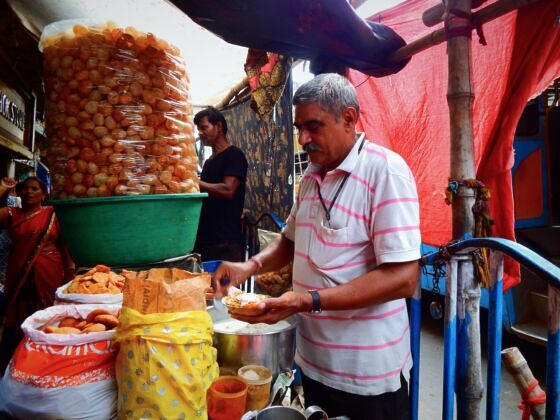CALLED PHUCHKA IN Calcutta, golgappa in Delhi , paani puri in Bombay and gup chup in Orissa, these flour balloons are tangy vegetarian delights enjoyed by the young and old, rich and poor. Phuchka stalls are a place for neighbours, friends and family to meet and greet and engage in conversation. Rumored to have come into existence as a treat for children (Golgappa was the name of a children’s magazine in the 1970s), there are different variations of phuchkas which are readily available. The most common form of phuchkas is the flour balloon with a filling made out of spicy potatoes and dipped in tamarind water. Then there is the dahi phuchka, which uses curd instead of tamarind water, the churmur which is made by crushing the phuchkas and then adding potatoes, green chillies, cumin, lemon juice, cilantro and tamarind pulp.

Where do you find phuchkas?
While you will find phuchka stalls in almost every part of an Indian city, there are certain restaurants that also sell phuchkas. If you want the authentic experience, you should try the stalls but if you are concerned about hygiene issues, then perhaps the restaurants are a safer option.
Open any of the local English Dailies – The Telegraph, The Statesman, The Times of India or the Hindustan Times – and you will find restaurants listed. The Food Court at Forum, Elgin road is known for serving phuchkas as is the food court at South City Mall on Prince Anwar Shah Road.
The street vendors famous for their phuchkas are Bacchu Prasad, who sits outside Jadavpur University with his phuchkas and is known for tasting the tamarind water himself before serving his customers, Jitendra Pandit of Vivekananda Park, who is popularly known for his use of gandharaj lebu (which literally translates as the lemon which is the king of all smells) and Kusheshwar Shah who serves his phuchkas at Mudiali and has hoisted a golf umbrella above his phuchka-stand to ensure that crows don’t come and peck at his savory treats.
Stand in a half circle and wait for the vendor to give you a bowl made out of sal leaf (sal is a leaf native to South Asia). The vendor will immediately prepare and distribute the phuchkas either in a clockwise or an anti-clockwise direction. Be sure to say amar hoye gecche (I am done) when you’re too full to eat anymore!
What makes you an expert phuchka eater?
Hold the phuchka with your hand and try to eat the entire phuchka at once. If the size of the phuchka is too large, break it up. Use the sal leaf to drain the tamarind water out of the phuchka, break it into two and continue eating. If you think the entire phuchka eating process is altogether too complex, opt for a churmur. The churmur is made up of pretty much the same ingredients but is served in the form of a chaat, a mix of ingredients in a small bowl. Usually, phuchka vendors also offers spoons so eating churmur is easier than eating a phuchka.
What if you’re a tourist and you’re feeling unsure?
Tourists are often scared to try the phuchka because they are apprehensive about how the tamarind water is prepared. Also, the vendor’s use of bare hands is known to drive some travelers away. In these situations, if you still want to try the phuchka, you should buy a bottle of mineral water and ask the vendor to try and prepare the tamarind water with that. Also request him to wash his hands thoroughly before preparing your phuchka.
If you’re still feeling iffy, you can opt for a restaurant that serves phuchkas but if you’re adventurous, I’d say that it is worth taking a chance on phuchkas.
How can you make phuchkas at home?
The preparation of the phuchka is divided into three parts- first the outer layer or the phuchka must be prepared. Secondly, you must prepare the stuffing and finally, the tamarind water. You can prepare this in any order of course, but this is exactly how I would do it.
For the phuchka:
One tablespoon of flour
One cup of sooji ( or semolina)
Half a teaspoon of baking soda (to make it fluffy)
And more than just a drizzle of oil- about five tablespoons (it has to be crispy and deep-fried)
First, mix the semolina, the flour, the salt, the baking soda and add some water so you can turn it into a dough. Divide the dough into as many phuchkas as you would like to make. All the phuchkas need to be shaped like circles.
Heat the oil and deep fry the circles until they are crisp and golden. Do not eat the phuchkas until they have cooled.
For the stuffing:
4 boiled potatoes (if you’re using large potatoes, 2 will suffice). Mash the potatoes with a fork or spoon and add one or two green chillies, depending on how spicy you like your food to be, or use dried chilli powder. You can also add cumin, although this is not absolutely necessary.
For the tamarind water:
1 tablespoon of finely chopped coriander
Half a tablespoon of rocksalt
2 spoons of sugar
1/2 a cup of tamarind extract
Mix all of the above and pour it into a large jug full of water. Your tamarind water is now ready.
You have now reached the final step of your phuchka-making endeavour. Stuff the potatoes into the phuchka and dip it into the tamarind water before eating. And remember, an expert phuchka eater puts the entire phuchka into her/ his mouth at once!